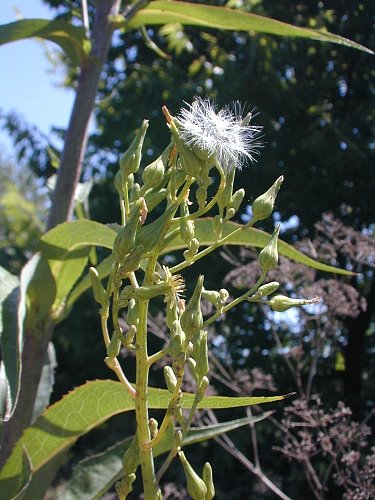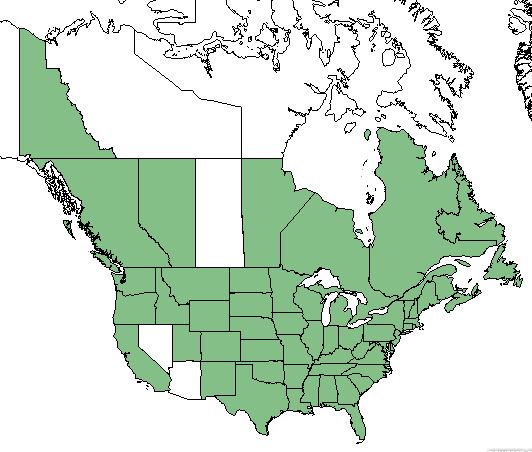Difference between revisions of "Lactuca canadensis"
| Line 30: | Line 30: | ||
==Ecology== | ==Ecology== | ||
===Habitat=== <!--Natural communities, human disturbed habitats, topography, hydrology, soils, light, fire regime requirements for removal of competition, etc.--> | ===Habitat=== <!--Natural communities, human disturbed habitats, topography, hydrology, soils, light, fire regime requirements for removal of competition, etc.--> | ||
| − | ''L. canadensis'' is found in fields, roadsides, disturbed ground,<ref name="Weakley 2015"/> thickets, forest edges, and in forest clearings (as cited in <ref name="Lebeda et al 2004">Lebeda A, Dolezalova I, Ferakova V, Astley D (2004) Geographical distribution of wild ''Lactuca'' species (Asteraceae, Lactuceae). Botanical Review 70(3):328-356.</ref>) | + | ''L. canadensis'' is found in fields, roadsides, disturbed ground,<ref name="Weakley 2015"/> thickets, forest edges, and in forest clearings (as cited in <ref name="Lebeda et al 2004">Lebeda A, Dolezalova I, Ferakova V, Astley D (2004) Geographical distribution of wild ''Lactuca'' species (Asteraceae, Lactuceae). Botanical Review 70(3):328-356.</ref>) Tennessee topsoil produced 2,683 individuals ha<sup>-1</sup> (26.83 individuals km<sup>-2</sup>).<ref name="Farmer et al 1982">Farmer RE Jr, Cunningham M, Barnhill MA (1982) First-year development of plant communities originating from forest topsoils placed on southern Appalachian minesoils. Journal of Applied Ecology 19(1):283-294.</ref> |
===Phenology=== <!--Timing off flowering, fruiting, seed dispersal, and environmental triggers. Cite PanFlora website if appropriate: http://www.gilnelson.com/PanFlora/ --> | ===Phenology=== <!--Timing off flowering, fruiting, seed dispersal, and environmental triggers. Cite PanFlora website if appropriate: http://www.gilnelson.com/PanFlora/ --> | ||
Revision as of 16:17, 31 January 2018
| Lactuca canadensis | |
|---|---|

| |
| Photo by the Illinois Wildflowers Database | |
| Scientific classification | |
| Kingdom: | Plantae |
| Division: | Magnoliophyta - Flowering plants |
| Class: | Magnoliopsida - Dicots |
| Order: | Asterales |
| Family: | Asteraceae |
| Genus: | Lactuca |
| Species: | L. canadensis |
| Binomial name | |
| Lactuca canadensis L. | |

| |
| Natural range of Lactuca canadensis from USDA NRCS Plants Database. | |
Common Name: American wild lettuce;[1] Canada lettuce[2]
Contents
Taxonomic Notes
Synonym: L. sagittifolia;[1][2] L. steelei[2]
Description
Lactuca canadensis is a dioecious annual and biennial that grows as a forb/herb.[2] Its inflorescence consist of a cluster of small pale yellow flowers. When crushed, its foliage excretes a milky juice. Leaves are alternate, simple, with lobed margins.[3] Leaf shape changes with available water and sunlight. Growth in Denver swamps produced larger leaves while plants in direct sunlight were more lobed than the non-lobed plants grown in shade.[4] In Nebraska, it reaches 61 in (1.55 m) in height and 27 in (0.69 m) wide on the surface.[3] Roots are tender and milky spreading out 35 in (0.90 m) and reaching 26 in (0.66 m) deep.[5]
Distribution
This species occurs in all of the lower 48 United States excluding Nevada and Arizona. In Canada, it is found in all the provinces except Saskatchewan, Nunavut, and Northwest Territories.[2]
Ecology
Habitat
L. canadensis is found in fields, roadsides, disturbed ground,[1] thickets, forest edges, and in forest clearings (as cited in [6]) Tennessee topsoil produced 2,683 individuals ha-1 (26.83 individuals km-2).[7]
Phenology
In the southeastern and mid-Atlantic United States, this species flowers from June through November.[1] Flowers on the Florida panhandle have been reported in May, June, and August, peaking in June.[8]
Use by animals
In Minnesota, browsing by white-tailed deer (Odocoileus virginianus) reduced the height (63.8 cm with browsing versus 136.9 cm without). Also, flowering was over 7 times greater on unbrowsed (231 flower heads per plant with browsing versus 1,725 without) L. canadensis plants.[9]
Conservation and Management
Cultivation and restoration
Photo Gallery
References and notes
- ↑ 1.0 1.1 1.2 1.3 Weakley AS (2015) Flora of the Southern and Mid-Atlantic States. Chapel Hill, NC: University of North Carolina Herbarium.
- ↑ 2.0 2.1 2.2 2.3 2.4 USDA NRCS (2016) The PLANTS Database (http://plants.usda.gov, 30 January 2018). National Plant Data Team, Greensboro, NC 27401-4901 USA.
- ↑ 3.0 3.1 Plant database: Lactuca canadensis. (30 January 2018) Lady Bird Johnson Wildflower Center. URL: https://www.wildflower.org/plants/result.php?id_plant=LACA
- ↑ Talbert CM, Holch AE (1957) A study of the lobing of sun and shade leaves. Ecology 38(4):655-658.
- ↑ Cole HE, Holch AE (1941) The root habits of certain weeds of southeastern Nebraska. Ecology 22(2):141-147.
- ↑ Lebeda A, Dolezalova I, Ferakova V, Astley D (2004) Geographical distribution of wild Lactuca species (Asteraceae, Lactuceae). Botanical Review 70(3):328-356.
- ↑ Farmer RE Jr, Cunningham M, Barnhill MA (1982) First-year development of plant communities originating from forest topsoils placed on southern Appalachian minesoils. Journal of Applied Ecology 19(1):283-294.
- ↑ Nelson G (30 January 2018) PanFlora. Retrieved from gilnelson.com/PanFlora/
- ↑ Shelton AL, Inouye RS (1995) Effect of browsing by deer on the growth and reproductive success of Lactuca canadensis (Asteraceae). The American Midland Naturalist 134(2):332-339.